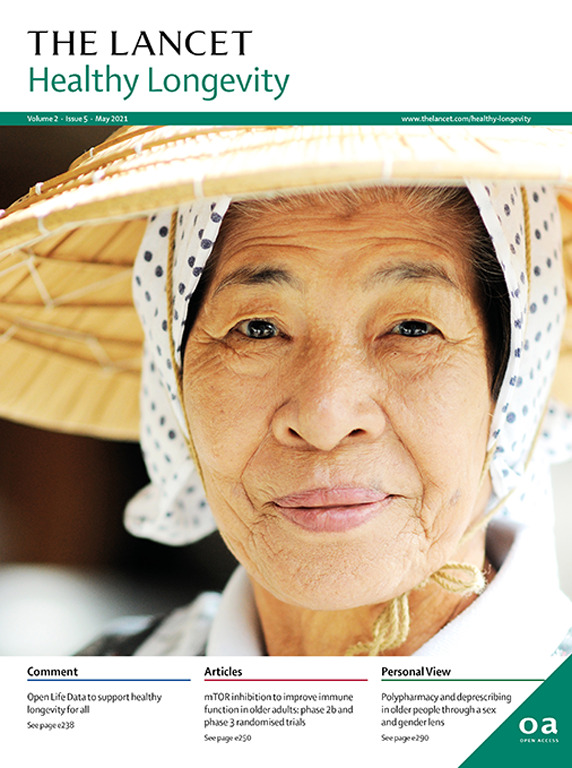1996-2021年期间47个国家和地区按方法确定的老年人自杀死亡率,并预测到2050年:一项全球时间序列和模型研究。
IF 14.6
Q1 GERIATRICS & GERONTOLOGY
引用次数: 0
摘要
背景:老年人的自杀率最高,但全面的全球研究有限。本研究旨在估计1996年至2021年47个国家和地区65岁及以上老年人的自杀死亡率,包括自杀方法分析,预测到2050年的未来死亡率,并确定相关因素。方法:本研究遵循《准确透明的健康评估报告指南》。我们从世界卫生组织死亡率数据库中提取了1996-2021年期间47个国家和地区老年人(≥65岁)的自杀死亡率数据。我们首先使用1996年至2021年的局部估计散点图平滑曲线估计自杀死亡率,并按性别、年龄亚组和自杀方法进行亚分析。然后,我们通过贝叶斯年龄-时期-队列(BAPC)模型估计了到2050年自杀死亡率的未来预测。我们还使用Das Gupta方法进行了分解分析,以确定导致1996年至2021年间自杀死亡人数变化的因素。最后,我们研究了2021年或最近可获得年份的自杀死亡率与国家级指标(贫困率、酒精使用障碍和精神障碍的残疾调整生命年(DALY)率、民用枪支拥有率和每片农田的农药使用量)之间的关系。结果:共有687443名老年人自杀死亡(男性75.2%,女性24.8%)被纳入分析。2021年,65岁及以上成年人的自杀死亡率为每10万人15.99人(95% CI为14.19 - 17.80),显著高于2021年所有年龄段的自杀死亡率10.87人(9.86 - 11.87)。(解读:尽管老年人自杀死亡率有所下降,但下降速度放缓和全球人口快速老龄化使其日益成为公共卫生关注的问题。枪支和杀虫剂等手段的可获得性与特定方法自杀率之间的关联支持了现有证据,即限制获得高致命性方法可以降低自杀死亡率。不同性别、年龄和国家自杀方式的差异,例如老年人使用枪支的频率较高,老年妇女使用药物或其他毒物的频率较高,可为有针对性的风险评估和预防战略提供信息。资助:惠康信托基金会和韩国国家研究基金会。本文章由计算机程序翻译,如有差异,请以英文原文为准。
Method-specific suicide mortality rates among older adults in 47 countries and territories, 1996–2021, with projections to 2050: a global time series and modelling study
Background
Suicide rates are highest among older adults, yet comprehensive global studies are limited. This study aimed to estimate suicide mortality rates among older adults aged 65 years and older across 47 countries and territories from 1996 to 2021, including analyses by suicide method, project future rates to 2050, and identify associated factors.
Methods
The study adhered to the Guidelines for Accurate and Transparent Health Estimates Reporting. We extracted suicide mortality data of older adults (≥65 years) across 47 countries and territories from the WHO Mortality Database for the period 1996–2021. We first estimated suicide mortality rates using a locally estimated scatterplot smoothing curve from 1996 to 2021, conducting subanalyses by sex, age subgroup, and suicide method. We then estimated future projections of suicide mortality rates to 2050 via Bayesian age-period-cohort (BAPC) modelling. We also performed a decomposition analysis using the Das Gupta method to identify factors contributing to changes in suicide death numbers between 1996 and 2021. Finally, we examined associations between suicide mortality rates in 2021 or the most recent available year and country-level indicators (poverty rate, disability-adjusted life-year [DALY] rates for alcohol use disorders and mental disorders, civilian firearm ownership, and pesticide use per cropland).
Findings
A total of 687 443 older adults who died by suicide (75·2% men, 24·8% women) were included in the analysis. The suicide mortality rate among adults aged 65 years and older was 15·99 deaths per 100 000 (95% CI 14·19–17·80) in 2021, significantly higher than the all-age suicide mortality rate of 10·87 deaths per 100 000 (9·86–11·87) in 2021 (p<0·0001). Firearms were more frequently used by older adults who died by suicide, compared with the total population (14·91% vs 9·88%, respectively; p<0·0001). The firearm-related suicide mortality rate among older adults was 2·44 per 100 000 (95% CI 2·00–2·89) in 2021, approximately twice that of individuals of all ages (1·09 per 100 000; 0·88–1·31; p<0·0001). There was an overall decline in suicide mortality rates among older adults from 1996 to 2021 (average annual percentage change [AAPC] –1·51 per 100 000; 95% CI –1·52 to –1·50), which was more pronounced among women (AAPC –2·24 per 100 000; –2·28 to –2·21) than in men (AAPC –1·45 per 100 000; –1·48 to –1·42; p<0·0001). Older age subgroups had smaller AAPCs (p<0·0001 for comparisons across all age subgroups). Notably, among adults aged 80 years and older, the suicide mortality rate by firearm showed no statistically significant change between 1996 and 2021. BAPC model projections suggest a slowing in the decline of suicide mortality rates among older adults to 2050. Decomposition analysis indicated that compared with 1996, the total number of suicides in 2021 increased by 7781 deaths primarily due to population growth. Suicide mortality rates among older adults generally increased with higher poverty rates, DALY rates for mental disorders and alcohol use disorders, as well as Human Development Index. Additionally, increasing civilian firearm ownership rates and pesticide use per cropland area were associated with higher suicide mortality rates among older adults who died by firearm and other poisoning, respectively.
Interpretation
Although suicide mortality rates among older adults have declined, the slowing pace of the decline and the rapid ageing of the global population make it an increasing public health concern. Associations between the availability of means such as firearms and pesticides and method-specific suicide rates support existing evidence that restricting access to highly lethal methods can reduce suicide mortality. Variation in suicide methods by sex, age, and country, such as the higher use of firearms among older adults and more frequent use of drug or other poisoning among older women, can inform tailored risk assessments and prevention strategies.
Funding
Wellcome Trust and National Research Foundation of Korea.
求助全文
通过发布文献求助,成功后即可免费获取论文全文。
去求助
来源期刊

Lancet Healthy Longevity
GERIATRICS & GERONTOLOGY-
CiteScore
16.30
自引率
2.30%
发文量
192
审稿时长
12 weeks
期刊介绍:
The Lancet Healthy Longevity, a gold open-access journal, focuses on clinically-relevant longevity and healthy aging research. It covers early-stage clinical research on aging mechanisms, epidemiological studies, and societal research on changing populations. The journal includes clinical trials across disciplines, particularly in gerontology and age-specific clinical guidelines. In line with the Lancet family tradition, it advocates for the rights of all to healthy lives, emphasizing original research likely to impact clinical practice or thinking. Clinical and policy reviews also contribute to shaping the discourse in this rapidly growing discipline.
 求助内容:
求助内容: 应助结果提醒方式:
应助结果提醒方式:


